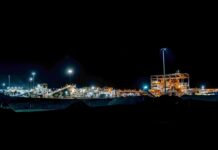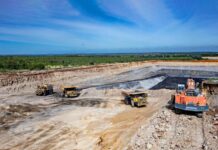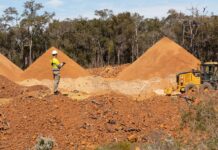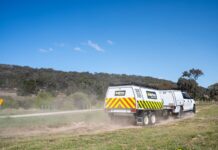The Queensland Government has given the green light to what will become one of the world’s largest steelmaking coal mines.
The granting of mining leases for the Olive Downs Coking Coal Project on September 29 was the last of the major approvals required to allow construction to start at the Bowen Basin mine.
The Pembroke Resources project will create up to 500 jobs during construction and more than 1000 new jobs in the region as it is developed to produce about 15mtpa of saleable coal over its 79-year mine life.
Pembroke CEO Barry Tudor told The Australian Mining Review the mine would provide a much-needed stimulus during the COVID-19 recovery, while generating about $5.5b in royalties for the Queensland Government.
“Taking an asset of this scale and significance from exploration through to a fully approved mine has had its challenges, but it is extremely satisfying to have reached this milestone in just four years,” Mr Tudor said.
“When in fully ramped up production, Olive Downs will be one of the world’s largest steel making coal mines.”
The project would commence production at 6mtpa (ROM) before expanding over the next decade to 20mtpa.
The mine will produce coking coal and has open-cut JORC reserves of more than 500mt, making it one of the largest metallurgical coal reserves in Queensland and the world.
Shovel-ready
Pembroke has hit the ground running, having already committed considerable resources in the development of many essential aspects of the project.
“This has included detailed engineering and construction plans for the processing plant, rail, water pipeline and electricity supply,” Mr Tudor said.
“The company has also secured port and rail capacity at Dalrymple Bay coal Terminal for the first 10 years of production.
“In 2018, Pembroke purchased more than 40,000ha of land to cover the first stage of production as well as critical environmental offset wildlife sanctuaries.”
Construction can now commence on-site with the $184m coal handling and processing plant (CHPP) construction contract having already been awarded to Sedgman and CPB Contractors.
The final stages of the tender process would soon be underway for mining services, rail-loop construction and haulage.
Pembroke is currently finalising the finance for the project, in addition to capital from shareholders.
Once this process is complete, on-site construction — expected to take 18 months — will start.
Stage one construction would cost about $500m on top of what has already been spent and would include the rail loop, powerline, water pipeline, access roads, CHPP and supporting infrastructure.
Each major capital work component is subject to a tender process and a mining services contractor would be appointed for the production phase for at least five years.
Mr Tudor said Pembroke is committed to using local suppliers wherever possible in the development and operation of Olive Downs.
“In addition to mining, the overall project will create opportunities across a range of support and ancillary operations and businesses including local suppliers, future workforce, local businesses, and community organisations,” he said.
“Pembroke has engaged extensively with key stakeholders to maximise the employment opportunities with local workers including the ability of workers to relocate to nearby regional towns.”
Workers would be encouraged to become a part of the local community around Moranbah.
Community Engagement
Pembroke was established by Mr Tudor to focus on the acquisition and development of high-quality steelmaking coal projects.
Pembroke was formally established in 2014 when Denham Capital, a global energy and resources private equity firm, committed to providing financial backing for the steelmaking coal strategy.
Although Olive Downs was the number one target of the Pembroke team, it was not initially for sale.
It was not until 2016 that it was successfully acquired, along with the mining domain of Willunga, from Peabody Energy.
Mr Tudor said Pembroke has adopted a “stakeholder centric strategy” in the development of Olive Downs over the last three years.
The strategy had focused on local, State and Federal Governments, Indigenous owners, the regional community and landholders.
“Effective liaison, interaction and negotiation with all stakeholders has been a key success factor for the project so far and it is considered a critical component to obtaining and maintaining the project’s ‘Social Licence to Operate’.”
Wildlife Protection
Mr Tudor said Pembroke had taken seriously the responsibility of protecting wildlife and minimising habitat disturbance at Olive Downs.
“Pembroke has developed strong environmental outcomes to support this responsibility and which are backed by robust environmental approvals at a State and Federal level,” he said.
A number of changes have been made to the mine plan to reduce the impacts to the habitat of the koala and greater glider, including the protection of the riparian corridor along the Isaac River.
“Additionally, areas identified as supporting koalas and greater gliders across the mining lease will be protected from activities,” Mr Tudor said.
“These areas will be actively managed to not only maintain but improve the quality of the habitat.
“For example, an area four times greater than the area used for mining will be provided for koala habitat as a wildlife sanctuary forever.”
Koala and greater glider exclusion fencing would be used on the mine site to direct both species to the protected zones away from active mining areas.
Other initiatives include speed limits to reduce the risk of vehicle strikes, radio tracking of the animals, a nest box program and opportunities for research programs with universities and conservation groups including the potential for a translocation program.
Pembroke has secured about 34,000ha, which will be legally secured in perpetuity, for the wildlife sanctuary.
“The development of Olive Downs is a unique opportunity,” Mr Tudor said.
“Projects of this quality, scale and lifespan, situated in a well-established coking coal area with access to existing infrastructure for power, water and rail, are extremely rare.
“As a world class tier one project, Pembroke is conscious that it must deliver the highest of standards in relation to the environment, the local community and local jobs.
“Our aim has been to anticipate and exceed requirements. The result is that Olive Downs will be a 21st century mine with a 21st century approach, generating much needed steelmaking coal from the best coking region in the world.”






















